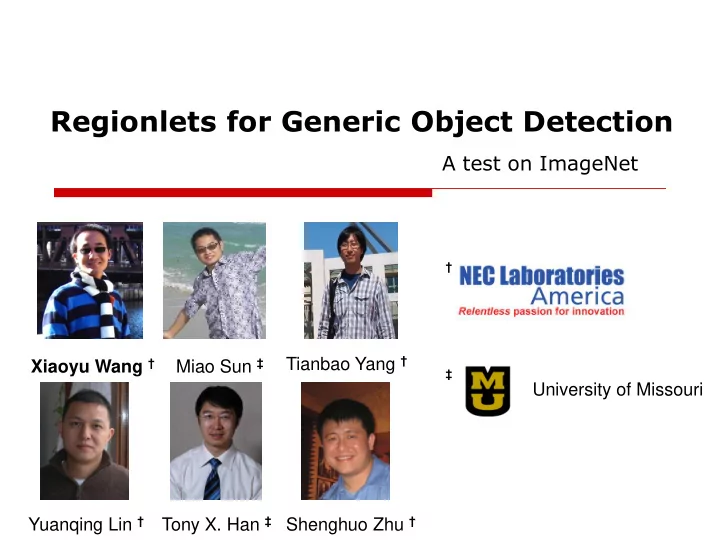

Regionlets for Generic Object Detection A test on ImageNet † Tianbao Yang † Xiaoyu Wang † Miao Sun ‡ ‡ University of Missouri Yuanqing Lin † Tony X. Han ‡ Shenghuo Zhu †
Introduction Generic object detection is challenging Rich deformation Arbitrary scales Arbitrary viewpoints Limitations of current state of the art Hand-crafted parameters to handle different degrees of deformation Sub-optimal multiple scales/viewpoints handling 12/14/2013 Regionlets for Generic Object Detection 2
Motivation A flexible and general object-level representation Data-driven deformation handling Multiple scales/viewpoints handling using a single and flexible model (Detecting an object at its original scale and aspect ratio) Fast and easy to be extended with different features 12/14/2013 Regionlets for Generic Object Detection 3
Detection Framework 3 1. B. Alexe , et. al. What is an object? CVPR 2010 2. K. E. A. Van de Sande, et. al. Segmentation as selective search for object recognition. ICCV 2011 3. X. Wang, et. al. Regionlets for Generic Object Detection. ICCV 2013 12/14/2013 Regionlets for Generic Object Detection 4
Regionlet: Definition Regionlets Feature Figure 1 extraction Region Detection bounding box 12/14/2013 Regionlets for Generic Object Detection 5
Regionlet: Definition( cont .) Relative normalized position Traditional Normalized (50,50,180,180) (.25, .25, .90,.90) Figure 2 12/14/2013 Regionlets for Generic Object Detection 6
Regionlet: Feature extraction Figure 3 Non-local pooling Could be SIFT, HOG, LBP , Covariance features, whatever feature your like! 12/14/2013 Regionlets for Generic Object Detection 7
Regionlets: Training Constructing the regions/regionlets pool Uniformly sample the position/configuration space of regions/regionlets Learning realBoost 1 cascades 16K region/regionlets candidates for each cascade Learning of each cascade stops when the error rate is achieved (1% for positive, 37.5% for negative) Last cascade stops after collecting 5000 weak classifiers Result in 4-7 cascades 2-3 hours to finish training one category on a 8-core machine 1. C. Huang, et. al. Boosting nested cascade detector for multi-view face detection. ICPR , 2004. 12/14/2013 Regionlets for Generic Object Detection 8
Deformation Handling Two-layers deformation handling Data-driven feature extraction region Larger region -> more robust to deformation Small region -> finer spatial layout Data-driven non-local max-pooling over regionlets Permutation invariance among regionlets Exclusive feature representation among regionlets 12/14/2013 Regionlets for Generic Object Detection 9
Scale/viewpoints Handling Arbitrary scale/viewpoints handling Coordinates of regionlets are normalized in a model Absolute regionlets coordinates are computed on the fly based on The normalized coordinates Resolution of the detection window Figure 4 12/14/2013 Regionlets for Generic Object Detection 10
Experiments Datasets PASCAL VOC 2007, 2010 20 object categories ImageNet Large Scale Object Detection Dataset 200 object categories Investigated Features HOG LBP Covariance Deep Convolutional Neural Network (DCNN) feature 12/14/2013 Regionlets for Generic Object Detection 11
Regionlets on PASCAL Table 1. Performance on the PASCAL VOC 2007 dataset (Evaluated using Average Precision or mean Average Precision: mAP, no DCNN feature, no outside data) Table 2: Performance comparison with state of the art 12/14/2013 Regionlets for Generic Object Detection 12
Regionlets on PASCAL Regionlets with Deep CNN feature (outside data) Table 3. Performance with Deep CNN feature Deep CNN convolutional layer feature (outside data) CNN(ImageNet) + layer5 + SVM 1 40.1% CNN(ImageNet) + layer5 + Hand-crafted feature + Regionlets 49.3% Deep CNN fine-tuned full connected layer feature (outside data) CNN(fine-tuned on PASCAL) + FC 7 + SVM 1 48.0% Will Regionlets model perform at 49.3% + 7.9% = 57.2% using fine-tuned full connected layer feature? 1. R Girshick, et. al. Rich feature hierarchies for accurate object detection and semantic segmentation. TR. 2013 12/14/2013 Regionlets for Generic Object Detection 13
Regionlets on ImageNet ImageNet Challenge Methods mAP UvA-EuVision 22.6% (with DCNN feature) Regionlets with deep features (1) 20.9% (with DCNN feature) Regionlets without deep features 19.6% (no DCNN feature) OverFeat-NYU 19.4% (DCNN) Toronto A 11.2% (N/A) SYSU_Vision 10.5% (N/A) (1) It’s a preliminary result, we have a better performance now! 12/14/2013 Regionlets for Generic Object Detection 14
Regionlets on ImageNet Performance on the validation dataset 12/14/2013 Regionlets for Generic Object Detection 15
Regionlets on ImageNet Top 3 easiest categories: butterfly 12/14/2013 Regionlets for Generic Object Detection 16
Regionlets on ImageNet Top 3 easiest categories: Basketball 12/14/2013 Regionlets for Generic Object Detection 17
Regionlets on ImageNet Top 3 easiest categories: Dog 12/14/2013 Regionlets for Generic Object Detection 18
Regionlets on ImageNet Top 3 hardest categories: backpack 12/14/2013 Regionlets for Generic Object Detection 19
Regionlets on ImageNet Top 3 hardest categories: Spatula 12/14/2013 Regionlets for Generic Object Detection 20
Regionlets on ImageNet Top 3 hardest categories: Ladle 12/14/2013 Regionlets for Generic Object Detection 21
Conclusions A new object representation for object detection Non-local max-pooling of regionlets Relative normalized locations of regionlets Flexibility to incorporate various types of features A principled data-driven detection framework, effective in handling deformation, multiple scales, multiple viewpoints Superior performance with a fast running speed (.2 seconds per image) 12/14/2013 Regionlets for Generic Object Detection 22
Recommend
More recommend